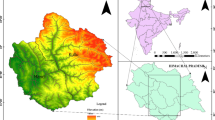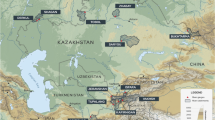Abstract
This study investigates trends in streamflow variables for 57 gauging stations distributed across the Ethiopian highlands for the period 1975–2010. We used the Mann-Kendall’s test to detect trends and the Sen’s slope estimator to calculate trend magnitudes. The findings show that more than 70% out of 513 test cases have shown increasing signals, and 32% of the tests were globally field significant at 0.05 level. Increasing change in low-flow magnitudes and decreasing change in low-flow frequency that exceeded 80 percentile (Qmin80p) were more prevalent than the others. Global field significant increasing changes were observed for 40% out of 228 test cases for low-flow amounts, while Qmin80p has shown decreasing trend at 46 out of 57 stations, and 26 of these were statistically significant. The general tendency is towards upward change, but there were some stations that showed field significant decreasing trends for high-flow indicators. General trend signals (upward or downward) and stations with significant changes did not show any spatial pattern. There were even adjacent gauging stations within the same river basin or adjacent river basins that showed statistically significant opposite trends for some test cases. The complex spatial pattern of trend signals is partly attributable to the very complex topographic, climatic, and land cover variations in the country that are well documented in previous studies. Also, the observed trends are difficult to fully explain in terms of climate change or land cover conversion. Generally, the results of this study contradict with previous studies that reported no significant trends in streamflow variables over Ethiopia. The study has important implications for climate change adaptation planning, water-related disaster risk management, and water sector development activities in the country.




Similar content being viewed by others
References
Awulachew SB, Yilma AD, Loulseged M, Loiskandl W, Ayana M, Alamirew T (2007) Water resources and irrigation development in Ethiopia. Colombo, Sri Lanka: International Water Management Institute. 78p. Working Paper, pp 1–123
Berehanu B, Seleshi Y, Assefa MM (2014). Surface Water and Groundwater Resources of Ethiopia: Potentials and Challenges of Water Resources Development. In: Nile River Basin: Ecohydrological Challenges, Climate Change and Hydropolitics.Springer, Switzerland, pp97–119
Bewket W, Conway D (2007) A note on the temporal and spatial variability of rainfall in the drought-prone Amhara Region of Ethiopia. Int J Climatol 27:1467–1477. https://doi.org/10.1002/joc.1481
Bewket W, Sterk G (2005) Dynamics in land cover and its effect on stream flow in the Chemoga watershed, Blue Nile basin, Ethiopia. Hydrol Process 19:445–458. https://doi.org/10.1002/hyp.5542
Billi P, Alemu YT, Ciampalini R (2015) Increased frequency of flash floods in Dire Dawa, Ethiopia: change in rainfall intensity or human impact? Nat Hazards 75:1373–1394. https://doi.org/10.1007/s11069-014-1554-0
Birhanu A (2014) Environmental degradation and management in Ethiopian highlands: review of lessons learned. IJEPP 2:24–34. https://doi.org/10.11648/j.ijepp.20140201.14
Birsan M, Molnar P, Burlando P, Pfaundler M (2005) Streamflow trends in Switzerland. J Hydrol 314:312–329. https://doi.org/10.1016/j.jhydrol.2005.06.008
Burn DH, Hag Elnur MA (2002) Detection of hydrologic trends and variability. J Hydrol 255:107–122. https://doi.org/10.1016/S0022-1694(01)00514-5
Burn DH, Sharif M, Zhang K (2010) Detection of trends in hydrological extremes for Canadian watersheds. Hydrol Process 24:1781–1790. https://doi.org/10.1002/hyp.7625
Cheung WH, Senay G, Singh A (2008) Trends and spatial distribution of annual and seasonal rainfall in Ethiopia. Int J Climatol 28:1723–1734. https://doi.org/10.1002/joc.1623
Conway D (2000) The climate and hydrology of the Upper Blue Nile River. Geogr J 166:49–62. https://doi.org/10.1111/j.1475-4959.2000.tb00006.x
Conway D, Schipper ELF (2011) Adaptation to climate change in Africa: challenges and opportunities identified from Ethiopia. Glob Environ Chang 21:227–237. https://doi.org/10.1016/j.gloenvcha.2010.07.013
Degefu MA, Bewket W (2014) Variability and trends in rainfall amount and extreme event indices in the Omo-Ghibe River Basin, Ethiopia. Reg Environ Chang 14:799–810. https://doi.org/10.1007/s10113-013-0538-z
Degefu MA, Bewket W (2017) Trends in extreme hydrological variables and teleconnections with large scale climate signals for Omo-Ghibe River Basin, Ethiopia. Environ Monit Asses 189:142. https://doi.org/10.1007/s10661-017-5862-1
Diro GT, Grimes DIF, Black E (2011) Teleconnection between Ethiopian summer rainfall and sea surface temperature: part I-observation and modeling. Clim Dyn 37:103–119. https://doi.org/10.1007/s00382-010-0837-8
Douben K (2006) Characteristics of river floods and flooding: a global overview, 1985-2003. Irrg Drain 55:9–21. https://doi.org/10.1002/ird.239
Douglas EM, Vogel RM, Kroll CN (2000) Trends in foods and low flows in the United States: impact of spatial correlation. J Hydrol 240:90–105. https://doi.org/10.1016/S0022-1694(00)00336-X
ECE (Economic Commission for Europe) (2009) Guidance on water and adaptation to climate change. Economic Commission for Europe Convention on the Protection and Use of Transboundary Watercourses and International Lakes, United Nation Publication, ISBN: 978-92-1-117010-8, New York and Geneva
FDRE (Federal Democratic Republic of Ethiopia) (2011) Ethiopia’s climate-resilient green economy: Green economy strategy. Addis Ababa
Gebrehiwot SG, Gärdenäs AI, Bewket W, Seibert J, Hstedt U, Bishop K (2014) The long-term hydrology of East Africa’s water tower: statistical change detection in the watersheds of the Abay Basin. Reg Environ Chang 14:321–331. https://doi.org/10.1007/s10113-013-0491-x
Hannaford J, Marsh TJ (2008) High-flow and flood trends in a network of undisturbed catchments in the UK. Int J Climatol 28:1325–1338. https://doi.org/10.1002/joc.1643
Jiménez Cisneros BE, Oki T, Arnell NW, Benito G, Cogley JG, Döll P, Jiang T, Mwakalila SS (2014) Freshwater resources. In: Kundzewicz Z (ed) Climate change 2014: impacts, adaptation, and vulnerability. Part a: global and sectoral aspects. Contribution of working group II to the fifth assessment report of the intergovernmental panel on climate change. Cambridge University Press, Cambridge, pp 229–269
Jury MR, Funk C (2013) Climatic trends over Ethiopia: regional signals and drivers. Int J Climatol 33:1924–1935. https://doi.org/10.1002/joc.3560
Khaliq MN, Ouardab TBMJ (2007) On the critical values of the standard normal homogeneity test (SNHT). Int J Climatol 27:681–687. https://doi.org/10.1002/joc.1438
Kundzewicz ZW, Graczyk D, Maurer T, Pińskwar I, Radziejewski M, Svensson C, Szwed M (2005) Trend detection in river flow series: 1. Annual maximum flow. Hydrol Sci J 50:797–810. https://doi.org/10.1623/hysj.2005.50.5.797
Kundzewicz ZW, Mata LJ, Arnell NW, Döll P, Kabat P, Jiménez B, Miller KA, Oki T, Sen Z, Shiklomanov IA (2007) In: Parry ML, Canziani OF, Palutikof JP, van der Linden PJ, Hanson CE (eds) Freshwater resources and their management. Climate change 2007: impacts, adaptation and vulnerability. Contribution of working group II to the fourth assessment report of the intergovernmental panel on climate change. Cambridge University Press, Cambridge, pp 173–210
Legesse D, Abiye TA, Vallet-Coulomb C, Abate H (2010) Streamflow sensitivity to climate and land cover changes: Meki River, Ethiopia. Hydrol Earth Syst Sci 14:2277–2287. https://doi.org/10.5194/hess-14-2277-2010
Mekasha A, Tesfaye K, Duncan AJ (2014) Trends in daily observed temperature and precipitation extremes over three Ethiopian eco-environments. Int J Climatol 34:1990–1999. https://doi.org/10.1002/joc.3816
Melesse A, Abtew W, Dessalegne T, Wang X (2009) Low and high flow analyses and wavelet application for characterization of the Blue Nile River system. Hydrol Process 24:241–252. https://doi.org/10.1002/hyp.7312
MoWIE (Ministry of Water, Irrigation and Energy) (2014) Ethiopia’s climate-resilient green economy climate resilience strategy: water and energy. Addis Ababa. http://www.greengrowthknowledge.org/sites/default/files/downloads/resource/Ethiopia_Climate_Resilient_Green_Economy_Water_Energy.pdf. Accessed 25 June 2014
Petrow T, Merz B (2009) Trends in flood magnitude, frequency and seasonality in Germany in the period 1951–2002. J Hydrol 371:129–141. https://doi.org/10.1016/j.jhydrol.2009.03.024
Rientjes THM, Haile AT, Mannaerts CMM, Kebede E, Habib E (2011) Changes in land cover and stream flows in Gilgel Abbay catchment, Upper Blue Nile basin-Ethiopia. Hydrol Earth Syst Sci 7:9567–9598. https://doi.org/10.5194/hess-15-1979-2011
Salmi T, Määttä A, Anttila P, Ruoho-Airola T, Amnell T (2002) Detecting trends of annual values of atmospheric pollutants by the Mann-Kendall test and Sen’s slope estimates—the excel template application MAKESENS. Publication on Air Quality No 31, Finnish Meteorological Institute, Air Quality Research, Helsinki, Finland. http://www.fmi.fi/organization/contacts_25. html. Accessed 12 Sep 2015
Segele ZT, Lamb PJ (2005) Characterization and variability of Kiremt rainy season over Ethiopia. Meteorog Atmos Phys 89:153–180. https://doi.org/10.1007/s00703-005-0127-x
Seleshi Y, Camberlin P (2006) Recent changes in dry spell and extreme rainfall events in Ethiopia. Theor Appl Climatol 83:181–192. https://doi.org/10.1007/s00704-005-0134-3
Svensson C, Kundzewicz ZW, Maurer T (2005) Trend detection in river flow series: 2. Flood and low-flow index series. Hydrol Sci J 50:811–824. https://doi.org/10.1623/hysj.2005.50.5.811
Taye MT, Willems P, Block P (2015) Implications of climate change on hydrological extremes in the Blue Nile basin: a review. J Hydrol 4:280–293. https://doi.org/10.1016/j.ejrh.2015.07.001
Tesemma ZK, Yasir AM, Steenhuis TS (2010) Trends in rainfall and runoff in the Blue Nile Basin: 1964–2003. Hydrol Process 24:3747–3758. https://doi.org/10.1002/hyp.7893
Viste E, Korecha D, Sorteberg A (2013) Recent drought and precipitation tendencies in Ethiopia. Theor Appl Climatol 112:535–551. https://doi.org/10.1007/s00704-012-0746-3
WMO (World Meteorological Organization) (2008) Manual on low flow estimation and prediction: operational hydrology report no. 50. Geneva: WMO-No. 1029
Worku FF, Werner M, Wright N, van-der-Zaag P, Demissie SS (2014) Flow regime change in an endorheic basin in southern Ethiopia. Hydrol Earth Syst Sci 18:3837–3853. https://doi.org/10.5194/hess-18-3837-2014
World Bank (2006) Ethiopia: managing water resources to maximize sustainable growth. World Bank, DC 20433, Washington D.C
Yue S, Pilon P, Phinney B, Cavadias G (2002) The influence of autocorrelation on the ability to detect trend in hydrological series. Hydrol Process 16:1807–1829. https://doi.org/10.1002/hyp.1095
Acknowledgments
We are very grateful to the Ethiopian Ministry of Water, Irrigation and Energy (MoWIE) for providing us with the daily streamflow data used for the study.
Funding
The first author received financial assistance provided by the International Foundation for Science (IFS, agreement no. W/5103-2) and African Climate Change Fellowship Program (ACCFP).
Author information
Authors and Affiliations
Corresponding author
Additional information
Editor: Erika Coppola
Publisher’s note
Springer Nature remains neutral with regard to jurisdictional claims in published maps and institutional affiliations.
Electronic supplementary material
ESM 1
(PDF 195 kb)
Rights and permissions
About this article
Cite this article
Degefu, M.A., Alamirew, T., Zeleke, G. et al. Detection of trends in hydrological extremes for Ethiopian watersheds, 1975–2010. Reg Environ Change 19, 1923–1933 (2019). https://doi.org/10.1007/s10113-019-01510-x
Received:
Accepted:
Published:
Issue Date:
DOI: https://doi.org/10.1007/s10113-019-01510-x




